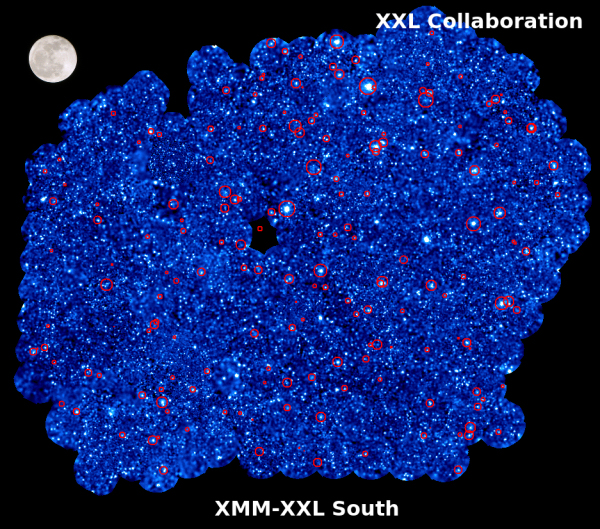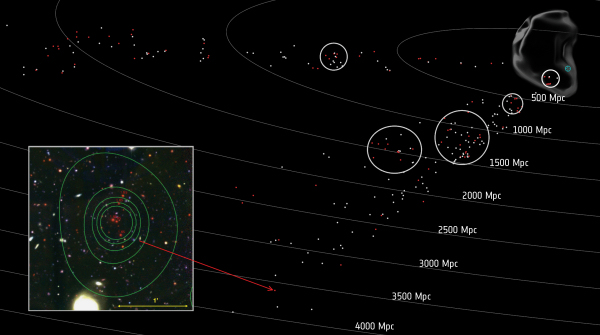Unravelling the Cosmic Web: Survey gives insights into Universe's structure
15 December 2015
Today marks the release of the first papers to result from the XXL survey, the largest survey of galaxy clusters ever undertaken with ESA's XMM-Newton X-ray observatory. The gargantuan clusters of galaxies surveyed are key features of the large-scale structure of the Universe and to better understand them is to better understand this structure and the circumstances that led to its evolution. The first results from the survey, published in a special issue of Astronomy and Astrophysics, hint at the answers and surprises that are captured in this unique bank of data and reveal the true potential of the survey.
 |
| XMM-Newton image of XXL-South field. Credit: ESA/XMM-Newton/XXL survey consortium |
The XXL project, the largest XMM-Newton observing programme to date, set itself the ambitious task of mapping galaxy clusters back to a time when the Universe was just half of its present age. Its aim was to trace the evolution of the large-scale structure of the Universe.
When looking at the large-scale distribution of matter in the Universe we see that it is not evenly distributed throughout space but forms a cosmic web of matter-filled filaments and a network of vast matter-less voids. Within these filaments huge swathes of matter have been pulled together by the effect of gravity into galaxy clusters, the largest bound entities in the Universe. Studying how these clusters evolve over time, in surveys like XXL, holds the key to uncovering how the arrangement of matter in the Universe has changed – the dense getting denser and the voids becoming emptier – and gives valuable insights into the accelerated expansion of the Universe and the factors that drive it.
"Tracing the evolution of cosmic structure is of special interest to astronomers," explains Marguerite Pierre, principal investigator of the XXL project. "How the structure has evolved depends on certain important factors like the density of the Universe and the acceleration of its expansion. The better our knowledge of how this structure has evolved, the more accurate our models of the Universe become. This in turn helps us to dig deeper into the nature of the most mysterious components of our Universe – dark matter and dark energy."
The XXL survey covered two huge regions each of which, if viewed on the sky, would have a two-dimensional area a hundred times larger than the full Moon, and that is without taking into account the depth that the survey explored. These already extensive swathes of sky were mapped back to a time when the Universe was half of its present age with a total of 450 galaxy clusters detected, and their properties and distributions mapped, in the process. This is no mean feat as, for many clusters, fewer X-ray photons were detected per cluster than there are galaxies in that cluster. Despite this meagre amount of information the team was still able to identify clusters much more easily than would be possible in visible or infrared light by detecting the huge reservoirs of gas that fill the space between the resident galaxies, rather than trying to pick out the light emitted by the visible matter in the clusters. These gas reservoirs are heated to a few tens of millions of degrees and can be detected as X-ray emission.
Today, the XXL team present their first results in a set of thirteen papers published in a special issue of Astronomy and Astrophysics. Among these initial findings, which are based on a catalogue of the 100 brightest clusters in the survey – also released today – the promise of shedding new light on dark energy and matter is already being met, with evidence emerging that could lead to refinements of current cosmological models.
Prior to the survey the XXL team made predictions about the number of clusters they expected to find, and how densely they expected them to be spread across the sky, by using data from ESA's Planck telescope, which measures the remnant radiation from the Big Bang. To do this requires careful calculation of how the Universe has expanded since its inception, a phenomenon driven by the energy content of the Universe. When the team analysed the data from XXL they found that the density of clusters was in fact lower than had been predicted by modelling using Planck data. Although the reason for the discrepancy remains unknown, it could imply that our Universe is somewhat different or more complex than the current cosmological model favoured by Planck or, alternatively, that our understanding of the physics and evolution of galaxy clusters needs to be improved. Further investigation will be carried out with the full sample of clusters in 2017.
"Constraining cosmological models requires large samples of galaxy clusters spanning a wide range of masses and redshifts," explains Pierre. "A finding like this, using only a fifth of the data XXL has to offer, highlights the potential of this unique and wide-reaching survey."
The first wave of findings has also led to better information about how the clusters themselves evolve. In one paper the team report that the X-ray properties of clusters in the past (at high redshifts) appear to be scaled replicas of local clusters, with properties such as luminosity and temperature changing only as a function of mass. This study of how the relationship between temperature, luminosity and mass changes as clusters grow over time was only possible due to the nature of the XXL data. The data allowed the astronomers to take careful account of the way that the clusters were chosen and ensure that those they were comparing and looking for differences within were in fact comparable in terms of their key properties. By comparing the identified scaling relationship with the one derived from simulations astronomers can build a much more accurate picture of what causes the clusters to evolve in the way they do.
Other findings included the discovery of five large-scale superclusters – clusters of galaxy clusters. Further study of these ancient cosmic giants will help astronomers to understand how they form and evolve into the superclusters we see today, which include the Laniakea supercluster, home to the Milky Way.
 |
| Distribution of galaxy clusters in the XXL survey. Credit: XXL survey consortium |
In addition to galaxy clusters the survey also detected around 25 000 active galactic nuclei, compact and highly luminous regions at the centre of some galaxies.
These findings represent only a fifth of the XXL data and demonstrate the potential of both the survey – with an analysis of the full cluster sample to become available in 2017 – and the surveying capabilities of XMM-Newton. However, the XXL survey is one of collaboration and these results were only possible due to the combined space- and ground-based observations, from the X-ray to the radio, which determined the properties of the clusters detected by XMM-Newton. Of special relevance was the ESO Large Programme, which ran from 2013 to 2015 and allowed astronomers to measure the distances to the detected galaxy clusters and map them not just in two-dimensional, but three-dimensional space. This is pivotal when tracking the evolution of the clusters over time.
"The XXL survey brought together some 100 scientists from around the world and these first exciting results were only possible because of this collaborative effort," tells Pierre. "The results, however, represent only the start of what the XXL survey has to offer. With some five times as many clusters the analysis of the final sample, released in 2017, will no doubt provide even further clues to the hidden nature of the Universe."
"The results published in this first set of papers from the XXL survey demonstrate the immense scientific value of such large projects," adds Norbert Schartel, ESA XMM-Newton Project Scientist.
More Information
A description of the survey, and some of the early science results, are presented in a series of thirteen papers published in the Astronomy & Astrophysics Journal today.
The European Space Agency's X-ray Multi-Mirror Mission, XMM-Newton, was launched in December 1999. The largest scientific satellite to have been built in Europe, it is also one of the most sensitive X-ray observatories ever flown. More than 170 wafer-thin, cylindrical mirrors direct incoming radiation into three high-throughput X-ray telescopes. XMM-Newton's orbit takes it almost a third of the way to the Moon, allowing for long, uninterrupted views of celestial objects.
XXL is an international project based around an XMM Very Large Programme surveying two 25 square degree extragalactic fields at a depth of about 5 x 10-15 erg cm-2 s-1 in the 0.5-2 keV band for point-like sources. Multi-band information and spectroscopic follow-up of the X-ray sources are obtained through a number of survey programmes.
Contacts
Marguerite Pierre
CEA, Saclay, France
Email: marguerite.pierre![]() cea.fr
cea.fr
Norbert Schartel
ESA XMM-Newton Project Scientist
Directorate of Science and Robotic Exploration
European Space Agency
Email: Norbert.Schartel![]() esa.int
esa.int
Phone: +34-91-8131-184


